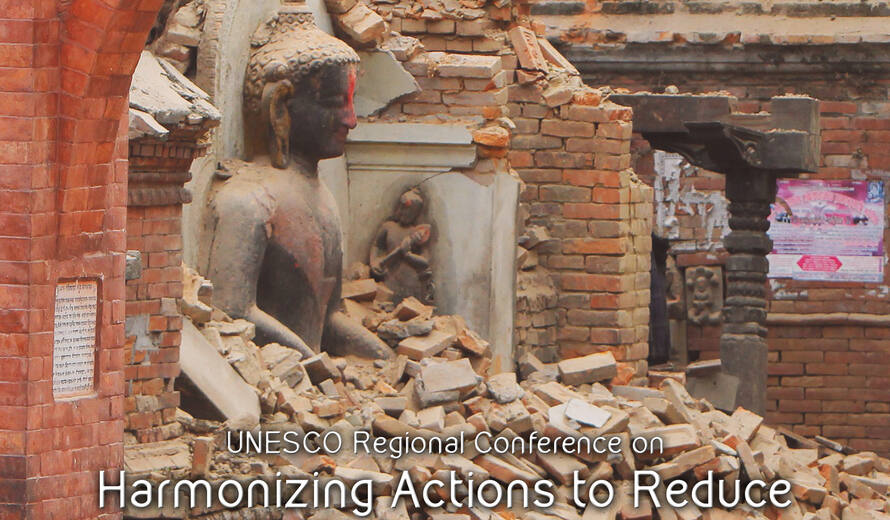Improved Safeguarding for Cultural Heritage Threatened by Armed Conflict and Natural Disasters Aim of Regional Conference
Armed conflict and natural disasters pose a dire threat to cultural heritage throughout the Asia-Pacific region. News stories are becoming all too frequent of priceless cultural treasures being damaged or lost forever and there are currently few measures in place to mitigate the effects of and recover from these dangers – even UNESCO World Heritage sites too often lack these safeguards.
The “Regional Conference on Harmonizing Actions to Reduce Risks for Cultural Heritage in Asia and the Pacific” will bring together a diverse group of experts in heritage conservation, disaster risk reduction to work towards greater regional cooperation in protecting our region’s precious cultural legacy.
What: “Regional Conference on Harmonizing Actions to Reduce Risks for Cultural Heritage in Asia and the Pacific”.
Highlight: UNESCO’s partner ThinkCity, will hold the “ThinkCity George Town Grants Programme exhibition”, showcasing the organization’s successful initiative in providing funds/matching funds to community organizations working to restore various heritage buildings in George Town.
More on the programme: www.thinkcity.com.my/tcgrants
When: 7-9 December 2015
Where: Hotel Jen, Penang, Malaysia
Who: UNESCO, host partner institution ThinkCity, a community-based “urban rejuvenation” organization, with support from ICOMOS - ICORP (International Council on Monuments and Sites, International Committee on Risk Preparedness), ICCROM (International Centre for the Study of the Preservation and Restoration of Cultural Property), and partner agencies UNISDR (United Nations International Strategy for Disaster Reduction), IFRC (International Federation of Red Cross and Red Crescent Societies), APDC (Asian Disaster Preparedness Centre) and UNDP (United Nations Development Programme).
More than 70 participants from 20 countries will be showcasing existing and emerging best practices and standards for enhancing resilience for cultural heritage in the context of disasters and armed conflicts.
HE Lim Guan Eng, Chief Minister of Penang will deliver welcoming remarks.
Opening remarks will be delivered by Ar. Laurence Loh, Director of Think City and Vibeke Jensen, Director of UNESCO Islamabad.
Keynote speeches will be delivered by Bhesh Narayan Dahal, Director-General, Department of Archaeology, Nepal and Dr. Terry Cannon, Research Fellow, Institute of Development Studies. Experts in heritage conservation from throughout the Asia-Pacific region will also be presenting at the conference. A full agenda with speaker details is attached.
Media Contact
In Malaysia: Please contact Kartina Mohamed at 04-2613146 /019-4000339 orkartina.mohamed@thinkcity.com.my
International: UNESCO Bangkok Media and Communications Officer Noel Boivin, n.boivin@unesco.org
Background
Reminders of the vulnerability of Asia-Pacific’s cultural heritage are all too frequent: the Kathmandu earthquake earlier this year; super typhoon Haiyan in the Philippines in 2013 and the devastating Tohoku earthquake and tsunami of 2011 are but a few examples. Armed conflict has compounded this threat, resulting in an upsurge in the deliberate destruction of historic sites and the illicit trade of cultural artefacts.
There is a need to ensure that appropriate measures for preparing for, responding to and recovering from disaster and armed conflict situations are reflected in cultural heritage policies and practices. Much needs to be done in terms of enhancing baseline information, building capacity and mobilizing resources at all stages from preparedness to recovery. The resilience of other immovable and movable cultural heritage also needs to be strengthened in the context of disaster risk reduction.
National disaster management authorities also need to better understand the importance of pro-active risk reduction for cultural heritage sites and institutions. Integrating disaster and armed conflict management plans for heritage properties with national and regional plans will ensure that risk reduction for heritage will be seen as part of broader national disaster risk reduction strategies.
This meeting builds on the momentum of the Third UN Disaster Risk Reduction Conference in Sendai, Japan, held earlier this year, where the global community made a commitment to mobilize more proactively to reduce disaster risks, a commitment enshrined in the Sendai Framework.
This conference seeks to advance that commitment by raising awareness of the importance of protecting cultural heritage in the face of increased risks from disasters and armed conflicts, showcasing best practices in protecting heritage and identifying obstacles and priorities for the integration of culture and heritage into regional initiatives and institutional frameworks for managing risks.
Sendai Framework for Action
Strategy for Risk Reduction at World Heritage Properties to strengthen the protection of World Heritage
Décisions (1)
Le Comité du patrimoine mondial,
- Ayant examiné le document WHC-07/31.COM/7.2,
- Rappelant la décision 30 COM 7.2, adoptée à sa 30e session (Vilnius, 2006),
- Prend note du résultat significatif de la Conférence internationale de Davos sur la réduction des risques liés aux catastrophes, comme le montre sa Déclaration finale sur le rôle du patrimoine dans le cadre de la réduction de ces risques;
- Approuve la version révisée de la Stratégie de réduction des risques sur les biens du patrimoine mondial, et sa liste d'actions prioritaires;
- Encourage les États parties, les Organisations consultatives et le Centre du patrimoine mondial à mettre en œuvre la Stratégie de réduction des risques sur les biens du patrimoine mondial dans leur domaine d'activité;
- Demande au Centre du patrimoine mondial et aux Organisations consultatives d'intégrer les politiques générales et les stratégies établies par le Comité du patrimoine mondial sur la question du changement climatique dans la mise en œuvre de la stratégie de réduction des risques sur les biens du patrimoine mondial;
- Recommande d'inclure une composante «Gestion des risques» dans le plan de gestion des biens du patrimoine mondial, conformément au paragraphe 118 des Orientations.
